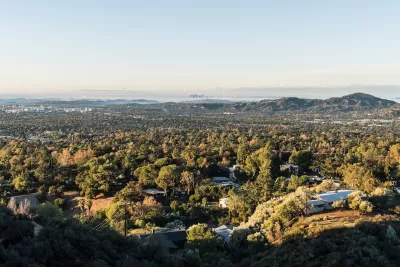The community has higher Black homeownership rates than most of Los Angeles, but now faces an uncertain future as residents struggle to rebuild.

Altadena, the center of one of January’s massively destructive wildfires in the Los Angeles area, was long a bastion of affordable and nondiscriminatory housing for Black families. “In past years, Altadena’s Black residents have had nearly double the homeownership rates of Black Americans across the Los Angeles county area – making the town a potential success story in efforts to shrink the racial wealth gap,” writes Lois Beckett in a piece for The Guardian.
Now, more than half of Altadena’s Black homeowners lost their homes, Beckett reports, putting residents at risk of displacement. According to an analysis by UCLA researchers, 61 percent of Altadena’s Black homes were within the Eaton Fire perimeter, and 48 percent of Black households were destroyed or majorly damaged.
The damage could eliminate decades of generational wealth built up by local families. The UCLA study also notes particular challenges that the Altadena community will face during recovery: more than half of Black homeowners are elderly, making them “especially vulnerable to incomplete or insufficient insurance coverage or predatory financial scams;” roughly 80 percent of Altadena homeowners are still paying off mortgages — on now-destroyed homes. Advocates are pressing for a 12-to-18-month mortgage deferment and a property tax freeze for affected families.
FULL STORY: California fires destroyed or damaged nearly half of Black homes in Altadena

Alabama: Trump Terminates Settlements for Black Communities Harmed By Raw Sewage
Trump deemed the landmark civil rights agreement “illegal DEI and environmental justice policy.”

Planetizen Federal Action Tracker
A weekly monitor of how Trump’s orders and actions are impacting planners and planning in America.

The 120 Year Old Tiny Home Villages That Sheltered San Francisco’s Earthquake Refugees
More than a century ago, San Francisco mobilized to house thousands of residents displaced by the 1906 earthquake. Could their strategy offer a model for the present?

In Both Crashes and Crime, Public Transportation is Far Safer than Driving
Contrary to popular assumptions, public transportation has far lower crash and crime rates than automobile travel. For safer communities, improve and encourage transit travel.

Report: Zoning Reforms Should Complement Nashville’s Ambitious Transit Plan
Without reform, restrictive zoning codes will limit the impact of the city’s planned transit expansion and could exclude some of the residents who depend on transit the most.

Judge Orders Release of Frozen IRA, IIJA Funding
The decision is a victory for environmental groups who charged that freezing funds for critical infrastructure and disaster response programs caused “real and irreparable harm” to communities.
Urban Design for Planners 1: Software Tools
This six-course series explores essential urban design concepts using open source software and equips planners with the tools they need to participate fully in the urban design process.
Planning for Universal Design
Learn the tools for implementing Universal Design in planning regulations.
Jessamine County Fiscal Court
Caltrans
Institute for Housing and Urban Development Studies (IHS)
City of Grandview
Harvard GSD Executive Education
Toledo-Lucas County Plan Commissions
Salt Lake City
NYU Wagner Graduate School of Public Service





























